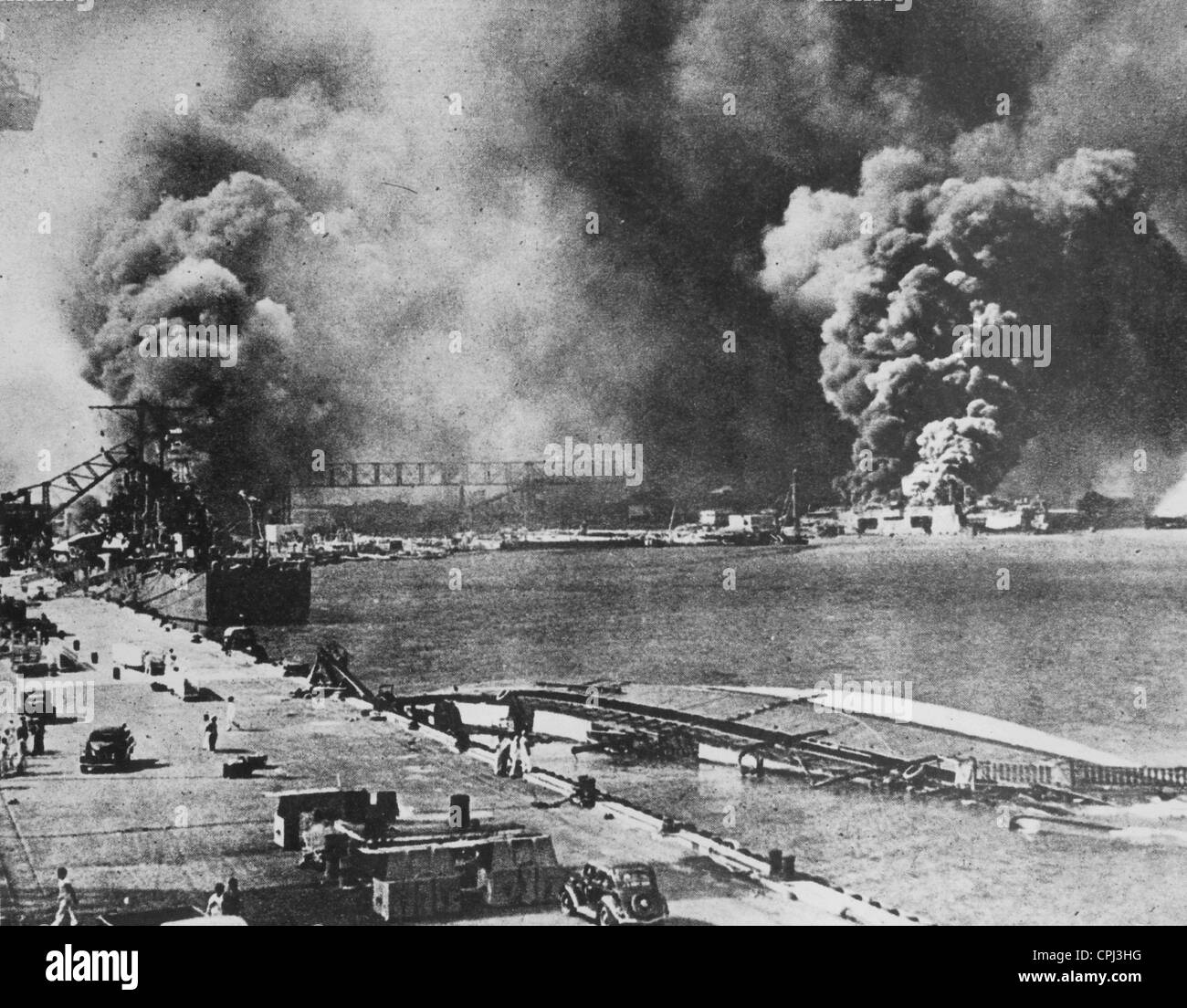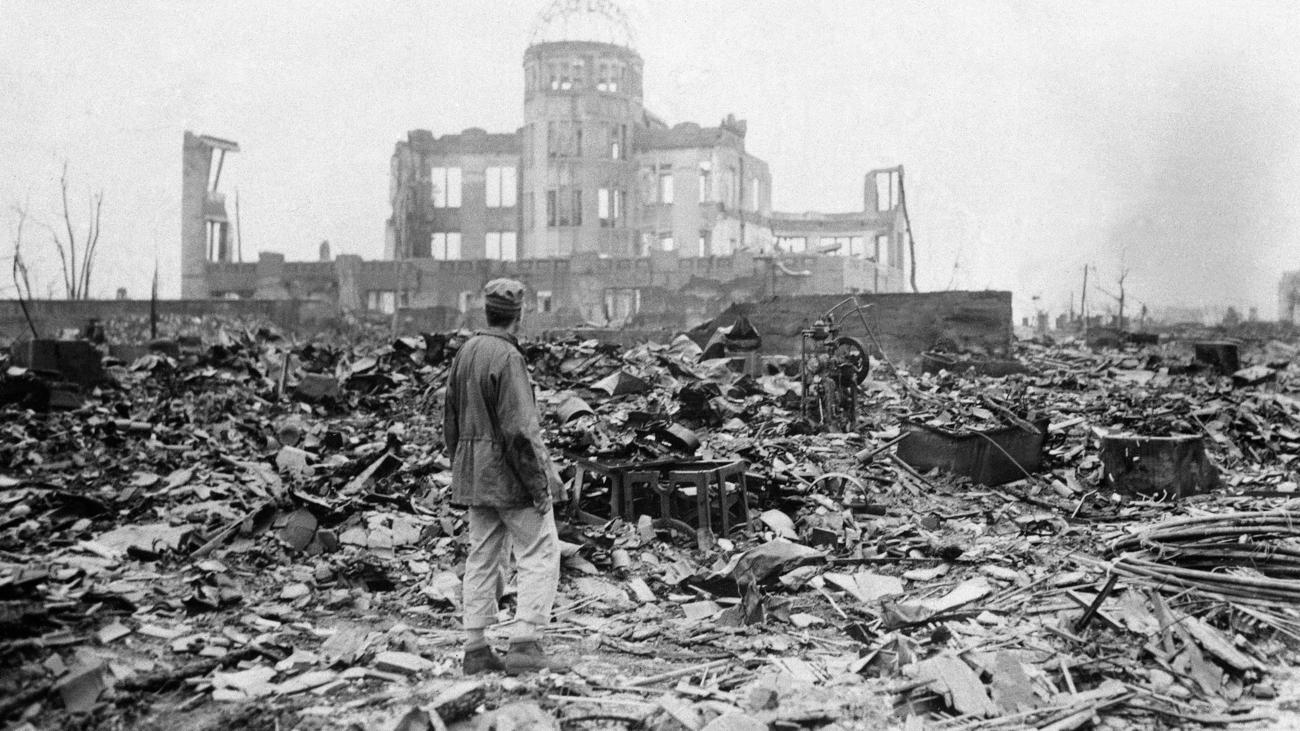Post-Hiroshima Nuclear Obama
https://www.youtube.com/watch?v=jY9VwCE_Dsg
http://media.graytvinc.com/images/800*450/Obama+Hiroshima.jpg
On the 27th May, 2016 President Obama paid a poignant visit to Hiroshima, Japan. He was the first American President to do so.
It was here at a quarter past eight in the morning of August 6th 1945 - up to that moment a beautiful summer's day - where America dropped its first atomic bomb, destroying a city and killing instantly killing 90,000–146,000 people and causing immeasurable suffering to countless others. It was of course followed by another at Nagasaki, with similar consequences, three days later.
At the time it was presented as a necessary measure to force Japan to surrender, thus saving countless young American lives. Nor was it seen as disproportionate, given what had been presented by Franklin D Roosevelt as "a date which will live in infamy when the United States of America was suddenly and deliberately attacked by naval and air forces of the Empire of Japan" at the Pacific Naval Base of 'Pearl Harbour'.
 http://c8.alamy.com/comp/CPJ3HG/attack-on-pearl-harbour-1941-bw-photo-CPJ3HG.jpg
http://c8.alamy.com/comp/CPJ3HG/attack-on-pearl-harbour-1941-bw-photo-CPJ3HG.jpg
In the British Parliament, the new Prime Minister Clement Attlee, read out a statement to MPs prepared by his predecessor Winston Churchill. It ended with the words: "We must indeed pray that these awful agencies will be made to conduce peace among the nations and that instead of wreaking measureless havoc upon the entire globe they become a perennial fountain of world prosperity." Perhaps we still need to keep praying?
With the benefit of the passage of time, we may well take a slightly more prosaic view both of the actions and predictions.
True, no atomic weapon has been exploded in anger since, although the threat of such hung like a mushroom cloud over the whole of the remaining century. It also poisoned the relationship between erstwhile allies against the Nazi threat (vis: America and the USSR) for the next fifty years in an increasingly nuclear weaponised and uncertain world.
Now no less than nine countries (USA; Russia; Britain; France; India; Pakistan; China; Israel; N. Korea) have the capacity to use them. Briefly but no longer South Africa also.
As can be seen in the amazing video below, the half century following the first bomb, over two thousand tests of nuclear devices were carried out with unquantifiable consequences for human health and the environment that are probably still evidencing themselves in damage to eco-systems and cancer rates in humans.
It is common ground that the peak in child leukaemia rates in the late sixties were directly related to radioactive pollution caused by overground testing. Other sites and types of adult cancers and genetic defects, particularly in vicinity of testing sites, may also be related. The total quantity of human suffering caused by these things is unquantifiable.

The post-war period saw a nuclear and other arms race driven by the United States, determined to remain in front of the technology and driven by a largely unnecessary fear of Communism and the USSR. The military/industrial complex was the beneficiary and promoter.
Untold resources were, and still are, being poured into a fearsome technology that effectively can never be used without profound adverse consequences for all life on earth. Nevertheless, and not of course mentioned by President Obama, the United States is pursuing a multi-billion dollar programme of modernising and up-grading its nuclear weapon systems, whilst doing everything it can to reignite hostility with Russia and China and rearming those geographical areas bordering them.
So when Obama uses rhetoric and gesture to emphasise reconciliation and lesson-learning, we need to subject it to closer examination. Words and gestures are one thing. Hard facts quite another.
In hindsight we might well conclude that America was very aware of Japan's intentions concerning Pearl Harbour and sacrificed it it as the pretext needed to enter the war.
Similarly that they needed a real test bed for the new weapon that could not be provided by Alamogordo, New Mexico where the first explosion took place on the 16th July 1945 - that is only three weeks previous to the Hiroshima bomb. The scientists and politicians needed not only to know the destructive energy it would produce but also the structural, human and environmental consequences and long-term health effects. Japan could be used as the laboratory because of the animosity stoked against it - some it, it must be said, justified.
 http://c6.nrostatic.com/sites/default/files/styles/original_image_with_cropping/public/uploaded/barack-obama-hiroshima-apology.jpg?itok=Oab7VZbZ
http://c6.nrostatic.com/sites/default/files/styles/original_image_with_cropping/public/uploaded/barack-obama-hiroshima-apology.jpg?itok=Oab7VZbZ
Was this the reason America rushed to demonstrate its terrible power so soon after its initial top-secret development and testing? It was not only an act to spare American lives and force the humiliating surrender of a proud nation, but a demonstration of global hegemonic military power. It was a warning to all nations what America could do if it put its mind to it.
Are these not the real reasons for bombing Hiroshima and Nagasaki rather than proving the destructive power of the weapon attached to an ultimatum to the Japanese people before using it?
Repeating a plea made in his 2009 Prague speech, Obama urged "the courage to escape the logic of fear" and held out hope for diligent, incremental steps to reduce nuclear stockpiles. "We may not realise this goal in my lifetime, but persistent effort can roll back the possibility of catastrophe," he said. "Their souls speak to us," Obama said of the dead. "They ask us to look inward, to take stock of who we are and who we might become."
 http://photos1.blogger.com/x/blogger/7114/258/400/209996/f11100a2002.jpg
http://photos1.blogger.com/x/blogger/7114/258/400/209996/f11100a2002.jpg
Indeed they do but will we listen? Does America have the courage to face up to its own deeds and redirect its energies away from militarism, confrontation and bombing others when it has failed so abysmally to face up to the criminal deception of 9/11 and the Middle East? I rather doubt it.
The Japanese Prime Minister Abe welcomed the president's message and offered his own determination "to realise a world free of nuclear weapons, no matter how long or how difficult the road will be." Of course Japan is also pursuing a policy of rearmament in the face of what it sees as a Chinese threat. Again actions speak louder than words.
Obama spent less than two hours in Hiroshima. Hopefully his aspirations will last longer. Should we be less cynical about the purpose of this visit? Was it really to indicate a genuine remorse for America's actions in the past and present concerning nuclear and military actions or in fact quite the opposite, reminding particularly China and North Korea that it is an ally of Japan now and that what it did in the past, it is equally, if not better prepared to do again in the future, if it sees fit?
Only time will tell.
BEGGING FORGIVENESS?
http://media.npr.org/assets/img/2016/04/11/obama-bows-to-emperor_custom-2c2b76d11f8e85547b60526e1a0710a1958a19c9-s900-c85.jpg
Perhaps the words of an Hiroshima survivor - a so-called 'hibakusha' - quoted in the London Times best sums up the attitude of the Japanese and other astute members of the human race? Hirosi Shimizu of the survivor organisation Hidankyo said, "The fact that Abe and Obama stand side-by-side before the Cenotaph does not mean there has been reconciliation. It's really all about them trying to strengthen the Japan-US nuclear alliance."

http://www.trbimg.com/img-55c37927/turbine/la-fg-70th-anniversary-atomic-bombing-pictures-010/1300/1300x731
The world may have been free of military nuclear explosions since 1945 (excluding that is all the nuclear tests and civil nuclear accidents) but this may have been more by luck than judgement. The general population is probably unaware how close we came on several occasions either by accident or miscalculation.
The 1962 Cuban Missile Crisis is probably best known (it came damn close to obliterating western civilisation!) but there have been many other instances where either nuclear weapons were recommended or threatened as in Korea, Vietnam and Iraq.
The early eighties saw a stand-off with Russia that almost resulted in a nuclear exchange. Of course depleted uranium was used in the two Gulf Wars with serious on-going health consequences for the civilian population.
The following abstract from an article by Jonathan Marshall for the 'Stategic Culture Foundation' website, lists at least ten near-miss incidents.
http://www.strategic-culture.org/news/2016/05/29/ticking-closer-nuclear-midnight.html
Jonathan Marshall is author or co-author of five books on international affairs, including The Lebanese Connection: Corruption, Civil War and the International Drug Traffic (Stanford University Press, 2012).
"National security experts and reporters such as Eric Schlosser, author of Command and Control (2014), have compiled long lists of nuclear accidents and near-misses, some of which might have cost millions of lives but for a few quick-thinking heroes. Here’s a small sample:
–In 1958, a B-47 dropped a 30 kiloton Mark 6 atomic bomb into a family’s backyard in Mars Bluff, South Carolina. Its high-explosive trigger blasted the home and left a 35-foot crater. A few months later, another B-47 dropped a Mark 39 hydrogen bomb near Abilene, again setting off its high explosives but not a nuclear blast.
–In 1961, a B-52 exploded over North Carolina, dropping two Mark 39 hydrogen bombs. One of them nearly detonated after five of its six safety devices failed. The Air Force never did recover the uranium trigger.
–In October 1962, at the height of the Cuban Missile Crisis, a Soviet submarine thought it was under attack from U.S. warships, which were practising dropping depth charges in the Sargasso Sea. The submarine commander ordered a launch of nuclear missiles, but was persuaded to stop by his second-in-command.
In 1962 Other near misses during that mother of all nuclear crises in 1962 included a reckless U.S. spy plane over-flight of Siberia, the explosion of a Soviet satellite that U.S. authorities interpreted as the start of a Soviet missile attack, American test launches of two nuclear-capable ICBMs, and a screw-up at a Minuteman site that allowed a single operator to launch a fully armed missile.
–In 1966, a B-52 bomber collided with a refuelling tanker over Palomares, Spain and broke apart, dropping its four hydrogen bombs. Two of them partially detonated, contaminating a wide region with radiation.
– In 1968 Two years later, a B-52 crashed in Greenland, losing three hydrogen bombs and contaminating nearly a quarter million cubic feet of ice and snow.
–In 1979, a technician mistakenly confused NORAD’s computers with a war games simulation, triggering signals of a Soviet nuclear launch. The Strategic Air Command scrambled its bombers before learning of the false alarm.
– In 1980 A year later, a defective computer chip prompted the Pentagon to waken President Jimmy Carter’s national security adviser with reports of a massive launch of Soviet missiles from submarines and land-based silos.
–In 1985, a glint of sunlight confused a Soviet early-warning satellite, which reported that the United States had launched five intercontinental ballistic missiles. Fortunately, the watch commander risked his career by not reporting the alarm, saving the day.
–In 1995, Russia’s early-warning system confused a small Norwegian weather rocket with an incoming U.S. Trident missile. The Russian military went on high alert, notifying President Boris Yeltsin and preparing a possible counter-attack before recognising the mistake."
LEST WE FORGET...
https://www.youtube.com/watch?v=arONMWblvG8
A mesmerising must-see time-lapse display of ... ?
https://www.youtube.com/watch?v=LLCF7vPanrY
And as for wars over the past thousand years:
https://www.youtube.com/watch?v=1hsDn2kNriI
You decide if as a species, humans are evolving into something better.
And as to how the U.S. Gov't contaminated its own land mass, lied to its own population and left trail of cancer and genetic disease see:
https://www.theguardian.com/film/2015/jun/06/downwinders-nuclear-fallout-hollywood-john-wayne?CMP=fb_gu
 https://www.theguardian.com/film/2015/jun/06/downwinders-nuclear-fallout-hollywood-john-wayne#img-1
https://www.theguardian.com/film/2015/jun/06/downwinders-nuclear-fallout-hollywood-john-wayne#img-1
Rory Carroll in St George, Utah
EXCERPT: "There is another, darker reason it endures in film lore. The photograph hints at it. Wayne clutches a black metal box while another man appears to adjust the controls. Wayne’s two teenage sons, Patrick and Michael, gaze at it, clearly intrigued, perhaps a bit anxious. The actor himself appears relaxed, leaning on Patrick, his hat at a jaunty angle. The box, which rests on a patch of scrub, looks unremarkable. It is in fact a Geiger counter.
"It is said to have crackled so loudly Wayne thought it was broken. Moving it to different clumps of rock and sand produced the same result. The star, by all accounts, shrugged it off. The government had detonated atomic bombs at a test site in Nevada but that was more than a hundred miles away. Officials said the canyons and dunes around St George, a remote, dusty town where the film was shooting, was completely safe.
"Last week, half a century later, Rebecca Barlow, a nurse practitioner at theRadiation Exposure Screening and Education Program (RESEP), which operates from the Dixie Regional Medical Center in St George, now a prosperous little city with an airport, leafed through her patient records. “More than 60% of this year’s patients are new,” she said. “Mostly breast and thyroid, also some leukaemia, colon, lung.”
"This is a story about cancer. About how the United States turned swathes of the desert radioactive during the cold war and denied it, bequeathing a medical mystery which to this day haunts Hollywood and rural Mormon communities and raises a thorny question: how much should you trust the government?
"And then, as years passed and cast and crew fell sick, it acquired a darker reputation. Powell got lymph cancer and died in 1963. “It got him pretty quickly,” said Norman. The same year Pedro Armendáriz, a Mexican actor who played Khan’s right-hand man, Jamuga, shot himself after being diagnosed with terminal cancer. Hayward, who played a Tartar princess, died of brain cancer in 1975.
"By the time Wayne succumbed to stomach cancer in 1979, The Conqueror had been dubbed an RKO Radioactive Picture. His sons Patrick and Michael battled – and survived – their own cancer scares. Whether out of guilt or some other reason, Hughes bought up all the copies of The Conqueror and reputedly watched it every night in his final, reclusive years.
"A People magazine article in 1980 reported that of 220 cast and crew, 91 had contracted cancer, with 46 of them dying. No bombs were tested during the filming, but the article quoted Robert Pendleton, director of radiological health at the University of Utah, saying radioactivity from previous blasts probably lodged in Snow Canyon. It also attributed an immortal quote to a scientist from the Pentagon’s defense nuclear agency: “Please, God, don’t let us have killed John Wayne”."
.jpg)

























